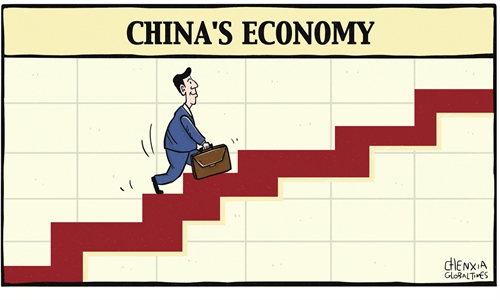
The Plaza 66 shopping mall on Nanjing road in Shanghai resumed business on June 1. The flow of people has increased and there are long queues in front of some luxury stores. Photo: Chen Xia/GT
According to the People's Bank of China (PBC), the central bank, the one-year loan prime rate (LPR) remains steady at 3.70 percent, and the five-year rate at 4.45 percent in June.
"The central bank keeping the LPR steady reflects that the recent economic recovery has basically met expectations, and that keeping lending rates at a reasonable level will continue to offer strong support for the domestic recovery," Dong Shaopeng, an expert advisor for the China Securities Regulatory Commission, told the Global Times on Monday.
The economy has gradually overcome the negative impact of the latest outbreak, with main indicators showing marginal improvement in May.
According to data from the National Bureau of Statistics, fixed-asset investment rose by 6.2 percent year-on-year in the first five months, while industrial output expanded 0.7 percent year-on-year last month, after falling 2.9 percent in April.
Banks across the country issued 1.89 trillion yuan ($282.1 billion) in new yuan loans in May, nearly tripling April's figure. Meanwhile, the amount of new loans increased by 392 billion yuan from the same period last year, the latest data from the PBC showed, suggesting a recovery in credit demand.
Deng Haiqing, chief economist at AVIC Fund Management Co, told the Global Times on Monday that another major reason for the steady LPR is serious concern over global inflation.
"Although China's inflation level is far lower than that of major economies, overly frequent interest rate cuts may lead to potential risks of domestic inflation," he said.
China's consumer price index (CPI) rose 2.1 percent year-on-year in May. Meng Wei, spokesperson for the National Development and Reform Commission, said at a press conference on Thursday that the country will see its CPI remain in a reasonable range, and it is capable of attaining the 3 percent annual goal.
The most recent change in the benchmark lending rate came in May, when the PBC cut the five-year LPR by 15 basis points to 4.45 percent.
Looking ahead, Dong forecast that there might be another cut of 15 basis points for the five-year LPR within this year to support a stable economic recovery given persistent difficulties and challenges, especially since the country's consumption remains weak.
However, Deng said that the central government is likely to adopt fiscal policies such as value-added tax credit refunds and subsidies to provide strong underpinnings for hard-hit businesses and families, as the effects of fiscal policy tools can be seen much quicker, while the country's interest rates are already comparatively low.
The Chinese government has ratcheted up support for the economy as major cities, including Shanghai and Beijing, have gradually eased COVID-19 restrictions following a drop in new infections.
A State Council executive meeting in May announced a package of 33 measures to stimulate growth, urging lenders to extend stronger credit support to struggling market entities.
Banks are encouraged to defer, within this year, principal and interest repayments on loans to micro-sized, small and medium-sized enterprises, self-employed households, truck loans, home loans and consumer loans owed by individuals facing temporary difficulties, according to the meeting.
The PBC recently reaffirmed its intention to implement a prudent monetary policy in 2022, saying that it will utilize aggregate and structural monetary policy tools to keep the economy running within a reasonable range.



